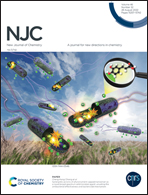Core–shell Co@CoO catalysts for the hydroformylation of olefins†
Abstract
A new strategy has been proposed for synthesizing Co@CoO core–shell nanoparticles with a core–shell structure, which involves a facile solvent-thermal process in deep eutectic solvents (DESs). In contrast to the irregular sheet-like packing material obtained in water, twinned and 3D-ellipsoid-shaped nanoparticles were achieved in choline chloride (ChCl)/glycerol and ChCl/PEG-300, respectively. It was found that the nanoparticles were featured as metal Co(0) cores homogeneously wrapped by CoO shells after reduction under a H2 atmosphere. The Co@CoO core–shell nanoparticles showed good activity and stability for the hydroformylation of olefins, and the conversion of 1-octene can reach 99% at 130 °C under 4 MPa (CO/H2 = 1) pressure, and the selectivity to C9 aldehydes was reached up to 97%. The characterization by XPS, H2-TPR and HRTEM indicated that metal Co(0) species could be an active site for hydroformylation of olefins. Notably, the leaching of cobalt carbonyl species was highly dependent on the surface molar ratio of Co2+/Co0 as revealed by XPS spectra, and the surface CoO layer played an important role in suppressing the loss of active Co species in hydroformylation of olefins. Moreover, the core–shell nano-catalysts are easily separated magnetically from the reaction mixture and showed good recyclability in nine consecutive catalytic runs.



 Please wait while we load your content...
Please wait while we load your content...